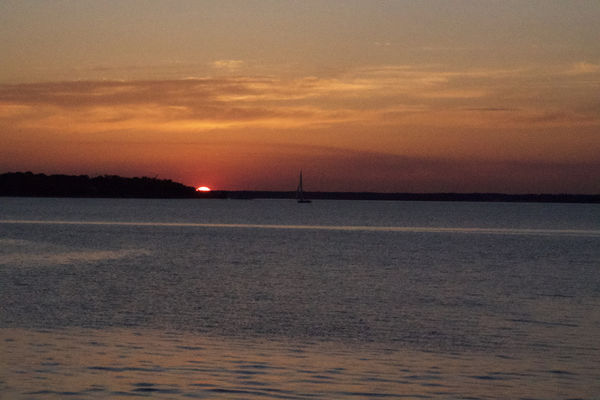Sunset problem
May 8, 2018 09:19:59 #
Last night at the restaurant I saw a good sunset developing. Went outside and shot (handheld) a series. Focus in the camera EVF was sharp, set to AWB, f/22 and various shutter speeds. The results were grainy when seen close. Done in Sony a7RIII with Sony 24 - 70 GM lens.
So, what should I have done?
So, what should I have done?
May 8, 2018 09:22:15 #
Noise is created from high ISO. Your ISO was 20,000 - whooeee  You could use a tripod so you can set slower shutter speed, and reduce ISO that way. Even hand-held, though, you surely didn't need 1/2500 second that this image is.
You could use a tripod so you can set slower shutter speed, and reduce ISO that way. Even hand-held, though, you surely didn't need 1/2500 second that this image is.
Lastly, usually f/22 is neither needed nor desired (for a few different reasons). So if handheld, 1/250 sec, f/8 or f/11 and whatever ISO gives you the darkness/mood you're going for.
Spend some time learning about exposure so that in fleeting opportunities, you aren't guessing. There is a "cause and effect" to changing any of the three elements associated with exposure: ISO, shutter speed, aperture.
You may have been able to handhold your camera steady at a shutter speed even slower than what I suggested, but you will only know that if you perform some controlled tests. While doing that, study the effects of shutter speed on motion within the scene itself (wind, waves, or moving subject)
Also do tests for depth of field with your f/stop. I learned that my mirrorless Panasonic G7 is sharpest - and provides plenty of depth of field for landscapes - at f/8 or even f/7.1, depending on focal length of my 14-140 mm lens.
See if your camera is included in this depth of field calculator:
http://www.dofmaster.com/dofjs.html
Note how distance and focal length affect the amount that will be in focus.
 You could use a tripod so you can set slower shutter speed, and reduce ISO that way. Even hand-held, though, you surely didn't need 1/2500 second that this image is.
You could use a tripod so you can set slower shutter speed, and reduce ISO that way. Even hand-held, though, you surely didn't need 1/2500 second that this image is. Lastly, usually f/22 is neither needed nor desired (for a few different reasons). So if handheld, 1/250 sec, f/8 or f/11 and whatever ISO gives you the darkness/mood you're going for.
Spend some time learning about exposure so that in fleeting opportunities, you aren't guessing. There is a "cause and effect" to changing any of the three elements associated with exposure: ISO, shutter speed, aperture.
You may have been able to handhold your camera steady at a shutter speed even slower than what I suggested, but you will only know that if you perform some controlled tests. While doing that, study the effects of shutter speed on motion within the scene itself (wind, waves, or moving subject)
Also do tests for depth of field with your f/stop. I learned that my mirrorless Panasonic G7 is sharpest - and provides plenty of depth of field for landscapes - at f/8 or even f/7.1, depending on focal length of my 14-140 mm lens.
See if your camera is included in this depth of field calculator:
http://www.dofmaster.com/dofjs.html
Note how distance and focal length affect the amount that will be in focus.
May 8, 2018 09:26:05 #
The exif data from the photo shows ISO of 20000. Not surprising it looks a little noisy. A more moderate aperture (maybe f8) would have permitted a lower ISO value resulting in less noise in the image. You also could have used a much slower shutter speed - why 1/2500 for a static scene such as this?
Sorry Linda - I see you covered the same issues while I was typing.
Sorry Linda - I see you covered the same issues while I was typing.
May 8, 2018 09:28:58 #
lsimpkins wrote:
No problem, I'm still editing my own. Besides, I'm sure at leave five more people will come along and repeat us both ...Sorry Linda - I see you covered the same issues while I was typing.

edit - lol, and there's one now!
May 8, 2018 09:35:15 #
fetzler
Loc: North West PA
Your ISO setting was 20000. Other settings are f22 and shutter speed 1/2500 sec. To reduce the noise you need to lower the ISO. You could easily reduce the shutter speed to 1/250. Depending on the movement of the water and sailboat lowering the shutter speed even more is quite possible even handheld. Lowering the shutter speed alone would allow ISO 2000. I don't think this shot should require f22 for any reason f5.6- f8 should. For f8 the iso would be about 250. Lowering the ISO will reduce the noise.
May 8, 2018 09:59:38 #
All have told you about the ISO. Now put the photo into whatever computer program you use and use the grain to make a statement. Sometimes grain, noise can be an asset.
May 8, 2018 10:01:22 #
Charlie157
Loc: San Diego, CA
lsimpkins wrote:
The exif data from the photo shows ISO of 20000.
How do you find out the exif data from the downloaded image?
May 8, 2018 10:18:05 #
Just a quick comment on aperture that has been alluded to. Beginning photographers learn that a smaller aperture (larger number) creates an image with more in focus. This is frequently translated, at least in the minds of beginning photographers as the smaller the aperture (again larger number) the sharper the image. More distances in focus is not the same as "sharper image". Forgetting, for the moment, the range of distances that are in focus, both larger and smaller apertures cause unsharpness. Larger apertures use the more of the lens glass closer to the edges of the lens which because of the physics is not as sharp as the central area. Also when light passes the sharp edge of the aperture blades a portion of that light is refracted or bent which reduces focus. Since a very small aperture has proportionally more edge the image becomes less sharp. (Wow, this is getting wordy) The short ending...both very small and very large apertures create less sharpness and staying near the center aperture numbers creates the sharpest image. Yes, there are very good reasons for using both very large and very small apertures but it requires compromising sharpness.
May 8, 2018 10:28:54 #
Linda From Maine wrote:
Noise is created from high ISO. Your ISO was 20,00... (show quote)
Linda, once again you come to the rescue! I mistakenly used the f/22 to try to get a starburst effect from the setting sun. This, of course, led to the other issues. I particularly appreciate the advice from your mirrorless experience. Just like getting to Carnegie Hall, it will take practice, practice, practice. Thanks again!
May 8, 2018 10:30:19 #
lsimpkins wrote:
The exif data from the photo shows ISO of 20000. Not surprising it looks a little noisy. A more moderate aperture (maybe f8) would have permitted a lower ISO value resulting in less noise in the image. You also could have used a much slower shutter speed - why 1/2500 for a static scene such as this?
Sorry Linda - I see you covered the same issues while I was typing.
Sorry Linda - I see you covered the same issues while I was typing.
I appreciate the quick response. Since the ISO was automatic, I did not pay attention. You and Linda have pointed that out and I will try to apply that lesson in the future.
May 8, 2018 10:31:56 #
fetzler wrote:
Your ISO setting was 20000. Other settings are f2... (show quote)
Thanks for responding. As I explained to Linda, I was using the f/22 to get a starburst effect from the sun. I learned my lesson from this experience because I blew a great opportunity.
May 8, 2018 10:33:02 #
captain ugly wrote:
All have told you about the ISO. Now put the photo into whatever computer program you use and use the grain to make a statement. Sometimes grain, noise can be an asset.
Well, Captain, now I am learning how to make lemonade out of a bunch of lemons. Thanks!
May 8, 2018 10:34:56 #
JimKing wrote:
Just a quick comment on aperture that has been all... (show quote)
Jim, thanks for taking the time to respond. It is through the helpfulness of hogs like you that I am gradually getting better. Thanks for taking the time!
May 8, 2018 11:21:13 #
JimKing wrote:
This is a super reply that even a non-technie such as myself can appreciate! Just a quick comment on aperture that has been all... (show quote)

Regarding Captain Ugly's response, experimenting with "playful pp" (or perhaps in this case, going more dramatic) is another joy of photography IMO!
Mike, regarding starburst - I don't think the sun was strong enough for that. I'm thinking it would need to be much brighter, but I've been known to be wrong before

May 8, 2018 11:31:29 #
Linda From Maine wrote:
This is a super reply that even a non-technie such... (show quote)
Never wrong with me!
If you want to reply, then register here. Registration is free and your account is created instantly, so you can post right away.




